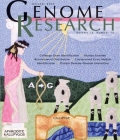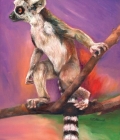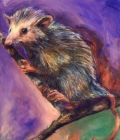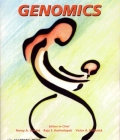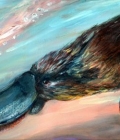Genistein methylates the fetal epigenome
Dolinoy, et. al. Environ Health Perspect 114:567-72 (2006)
Maternal dietary genistein supplementation of mice during gestation was shown in this paper to shift the coat color of Avy offspring from yellow to pseudoagouti by altering the epigenome rather than mutating the genome; a clear example of nature via nurture. Genistein, the major phytoestrogen in soy, is linked to diminished female reproductive performance and to cancer chemoprevention and decreased adipose deposition. Dietary genistein may also play a role in the decreased incidence of cancer in Asians compared with Westerners, as well as increased cancer incidence in Asians immigrating to the United States.
- Science News
April 24, 2006
Nurture takes the spotlight decoding the environment's role in...
- Environmental Health Perspectives
March 31, 2006
Color by soy genistein linked to epigenetic effects
- Duke Med News
March 26, 2006
Prenatal genistein in soy reduces obesity in offspring via...
August 9, 2012Tweet
Genome-wide prediction of imprinted murine genes
Luedi, et. al. Genome Res 15:875-84 (2005)
A machine learning approach was used to both identify imprinted gene candidates and predict their parental expression preference across the entire mouse genome. This subset of genes is particularly important medically becasue imprinted genes could function as targets for linking environmental exposures during pregnancy to the susceptibility of developing chronic disorders as adults. Among those predicted to be imprinted are strong candidate genes for complex human conditions where parent-of-origin inheritance is involved, including Alzheimer disease, autism, bipolar disorder, diabetes, male sexual orientation, obesity, and schizophrenia.
- Wall Street Journal
June 23, 2005
Imprinted genes offer key to some diseases and to possible cures
August 9, 2012Tweet
Nobel symposium lecture
Dr Jirtle was invited to speak at the Nobel Symposium on Epigenetic Reprogramming in Development and Disease, held June 19-21, 2004 in Stockholm. He spoke on the “Biological Consequences of the Divergent Evolution of M6P/IGF2R Imprinting".
August 9, 2012Tweet
You are what your mother ate!
Waterland and Jirtle. Mol Cell Biol 23:5293-300 (2003)
Dietary supplementation with extra folic acid, vitamin B(12), choline, and betaine alters the phenotype of Agouti mouse offspring via increased CpG methylation, suggesting that dietary supplementation, long presumed to be purely beneficial, may have unintended deleterious influences on the establishment of epigenetic gene regulation in humans.
- ABC News (Australia)
August 3, 2006
Diet affects genetic expression, study finds - Dallas Morning News
November 1, 2003
Genetics’ accomplice: emerging field of epigenetics hints at... - Dallas Morning News
November 1, 2003
Epigenetics may have many roles - New York Times
October 6, 2003
A pregnant mother's diet may turn the genes around - The Scientist
September 7, 2003
Eating for two, or an entire lineage
- Wall Street Journal
August 21, 2003
Diet during pregnancy may have effects lasting into adulthood - Wall Street Journal
August 14, 2003
Chubby blonde? Slim and dark? Lab mice take after mom's diet - Guardian
August 6, 2003
Vitamins change colour of baby mice - Nature
August 3, 2003
Mother's diet changes pups' colour - BBC News
July 31, 2003
Maternal diet vital to offspring
- DukeMed News
July 31, 2003
Common nutrients fed to pregnant mice altered their offspring's... - HealthScout
July 31, 2003
What mom eats can change coat color in offspring - Herald-Sun
July 31, 2003
Duke study may push research past gene mutations - New Scientist
July 31, 2003
You are what your mother ate, suggests study - ScienCentral News
July 31, 2003
Blame your mother
August 6, 2012Tweet
Callipyge mutation identified
Freking, et. al. Genome Res 12:1496-506 (2002)
A small genetic region near the telomere of ovine chromosome 18 was previously shown to carry the mutation causing the callipyge muscle hypertrophy phenotype in sheep. The mutation lies in a region of high homology among mouse, sheep, cattle, and humans, but not in any previously identified expressed transcript. Initial functional analysis indicates the sequence encompassing the mutation is part of a novel transcript expressed in sheep fetal muscle named CLPG1.
- ABC Rural News
September 15, 2002
Researchers discover the Schwarzenegger of sheep - Actualiteiten
September 15, 2002
Gen voor grote, gespierde billen - AgBiotechNet
September 15, 2002
'Beautiful buttocks' pinned down - ARS News
September 15, 2002
Sheep genes may aid medical researchers - CBC News
September 15, 2002
Big-bottomed sheep show rare mutation for muscle - Chicago Tribune
September 15, 2002
The mystery behind a sheep's behind
- Daily Mail
September 15, 2002
Why your bum looks big in this - DukeMed News
September 15, 2002
Big-bottomed sheep have a rare genetic mutation that builds... - Health Scout News
September 15, 2002
Bah-uns of steel: muscular sheep have gene mutation that... - Nature
September 15, 2002
Mutation gives sheep beautiful buttocks DNA change between genes... - Nature Rev Genet
September 15, 2002
More than just a pretty face
- Noticias locas
September 15, 2002
Aislan el gen del culo gordo - Toronto Star
September 15, 2002
Science gives Aphrodite a pain in the butt - UPI
September 15, 2002
Big-bottomed sheep a genetic mystery - USA Today
September 15, 2002
Scientists get to the bottom of a big sheep mystery - Ylift
September 15, 2002
You want an ass like a sheep? Maybe...
August 6, 2012Tweet
Divergent evolution in M6P/IGF2R imprinting: implications for cloning and cancer
Killian, et. al. Hum Mol Genet 10:1721-8 (2001)
M6P/IGF2R imprinting first appeared approximately 150 million years ago following the divergence of prototherian from therian mammals. Following this, M6P/IGF2R is imprinted in Artiodactyla, as it is in Rodentia and Marsupialia, but not in Scandentia, Dermoptera and Primates, including ringtail lemurs and humans. The absence of M6P/IGF2R imprinting in extant primates, due to its disappearance from the primate lineage over 75 million years ago, demonstrates that imprinting at this locus does not predispose to human disease. Moreover, the divergent evolution of M6P/IGF2R imprinting predicts that the success of in vitro embryo procedures such as cloning may be species dependent.
- JAMA
February 28, 1997
Epigenetics is seen as possible key to cloning - BBC Frontiers
February 28, 1997
Interview: human cloning
- DukeMed News
February 28, 1997
Humans may be easier to clone than sheep and mice because of a... - JNCI
February 28, 1997
Platypus study answers questions about gene imprinting
- New York Times
February 28, 1997
Researchers discount a caution in debate over cloned humans - Science News
February 28, 1997
Dolly was lucky: scientists warn that cloning is too dangerous...
August 6, 2012Tweet
Marsupials and eutherians reunited
Killian, et. al. Mamm Genome 12:513-7 (2001)
The three living divisions of mammals are monotremes, marsupials and 'placental' mammals. Determining the sister relationships among these three groups is the most fundamental question in mammalian evolution. Statistical analysis of the M6P/IGF2R unambiguously supports the morphology-based Theria hypothesis of mammalian evolution that excludes monotremes from a clade of marsupials and eutherians.
- DukeMed News
July 16, 2001
Kangaroo, platypus not related after all: Duke scientists refute...
- The Times
July 16, 2001
Kangaroo finding is a leap forward
August 6, 2012Tweet
Imprinting of PEG3
Murphy, et. al. Genomics 71:110-7 (2001)
The paternally expressed Peg3 gene in mice encodes an unusual Kruppel-type zinc finger protein implicated in critical cellular and behavioral functions including growth, apoptosis, and maternal nurturing behavior. The imprinted status of PEG3 throughout life coupled with its neural expression and putative roles in regulating cell growth suggests that PEG3 may be a susceptibility locus for cancer as well as neurobehavioral deficits.
- Duke Chronicle
January 9, 2001
Scientists discover imprinted gene on chromosome 19: a gene that...
- Duke Dialogue
January 9, 2001
Imprinted gene found on human chromosome 19: mouse version...
August 6, 2012Tweet
M6P/IGF2R imprinting evolution in mammals
Killian, et. al. Mol Cell 5:707-16 (2000)
M6P/IGF2R is not imprinted in monotremes and does not encode for a receptor that binds IGF2. In contrast, M6P/IGF2R is imprinted in a didelphid marsupial, the opossum, but it strikingly lacks the element postulated to be involved in imprint control. Thus, invasive placentation and gestational fetal growth are not required for imprinted genes to evolve. These results also suggest that these two functions evolved in a mammalian clade exclusive of monotremes.
- Duke Dialogue
April 4, 2000
Platypus and opossum studies reveal origin of genetic battle of...
- Guardian
April 4, 2000
Put in on the bill
- New Scientist
April 4, 2000
Mum versus Dad: a genetic battle is being fought inside...
August 6, 2012Tweet
 Newer Entries
Newer Entries


